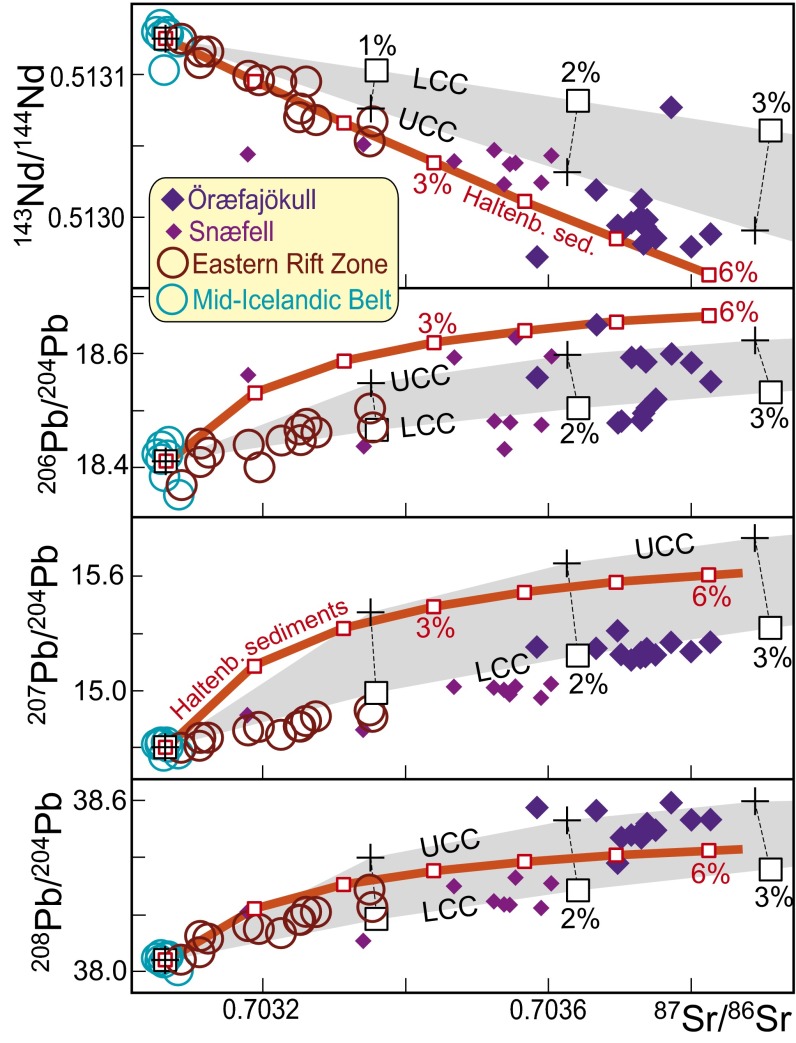Fig. 5.
Mixing models for the Continental Crust Contamination Trend (CCCT), starting from the average composition of Mid-Icelandic Belt (MIB) basalts (14). Only the seven MIB sample localities that do not overlap with the Western, Eastern, and Northern Rift Zones are used. Their average values for Sr–Nd–Pb concentrations and isotope ratios used in the models are 114.86, 5.4457, and 0.25814 ppm, and 0.703064, 0.513075, 18.41086, and 38.03957, respectively. The basalt data for the Eastern Rift Zone and Eastern Volcanic Flank Zone (the Snæfell and Öræfajökull central volcanoes) are as in Fig. 3. Three different contamination models, labeled UCC (upper continental crust), LCC (lower continental crust), and Haltenbanken sediments, are shown. The UCC and LCC components have identical isotope ratios but different trace element concentrations. The isotope ratios are derived from assimilation trends observed in East Greenland Tertiary basalts from the Hold with Hope area (21). The components are chosen to be consistent with the contamination trends defined by the upper series lavas (tables 1C and 3 in ref. 23). The black crosses and squares represent 1% increments of UCC and LCC components with 87Sr/86Sr, 143Nd/143Nd, 206Pb/204Pb, 208Pb/204Pb, and 208Pb/204Pb ratios of 0.712, 0.5122, 18.7, 15.7, and 38.8, respectively. The trace element concentrations of a partially resorbed charnokitic xenolith are not suitable model concentrations due to extensively modified chemistry (23). Instead, we model two alternative sets of element concentrations based on Zartman and Haines (24): (i) UCC (black crosses): Sr, Nd, and Pb concentrations of 378, 32, and 23 ppm, respectively, and (ii) LCC (black squares): Sr, Nd, and Pb abundances of 389, 14, and 6 ppm, respectively. Generally, these models illustrate that the Snæfell and Öræfajökull basalts could have been derived from basaltic melts with MIB composition by assimilation of 1–3% continental crust of isotopic composition similar to the northeast Greenland contaminants. The exposed continental crust of the central east Greenland Blosseville Kyst (21, 22) has too unradiogenic Pb-isotope compositions to be responsible for the southeast Iceland CC-contamination trend. The alternative Haltenbanken sediment model is based on an average of 116 sediment samples (Dataset S1) from the mid-Norway continental shelf. The 87Sr/86Sr, 143Nd/143Nd, 206Pb/204Pb, and 208Pb/204Pb ratios are 0.72587, 0.51197, 18.74, 15.64, and 38.53, and the Sr, Nd, and Pb concentrations are 62, 15, and 15 ppm, respectively. This clastic sediment model results in a higher CC-fraction of 2–6% to yield the Snæfell and Öræfajökull basalts.

